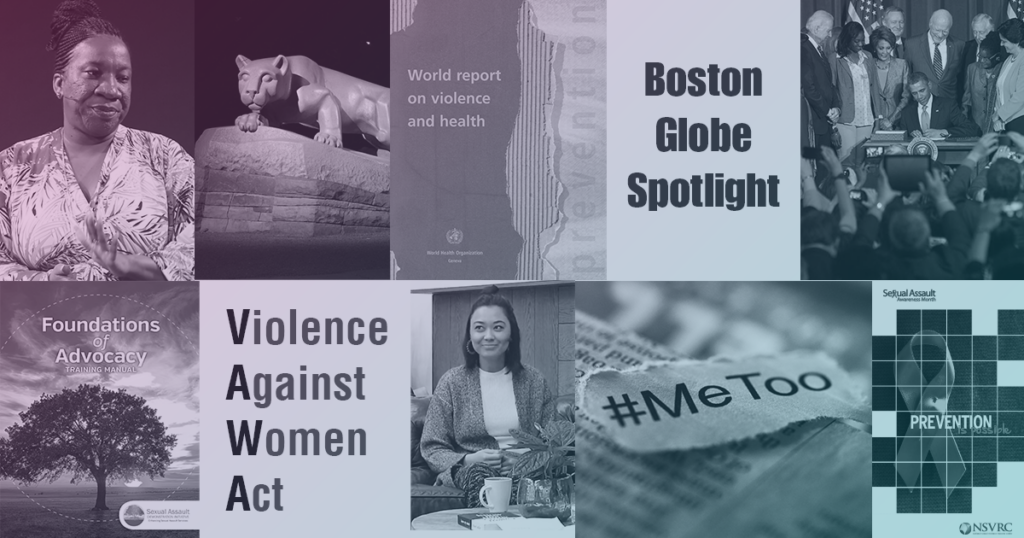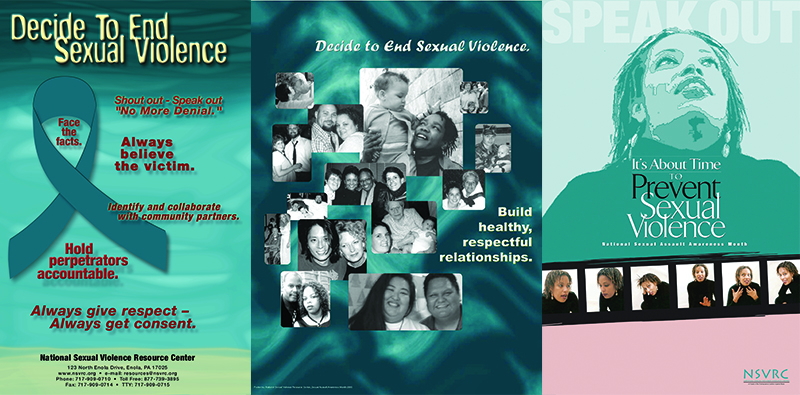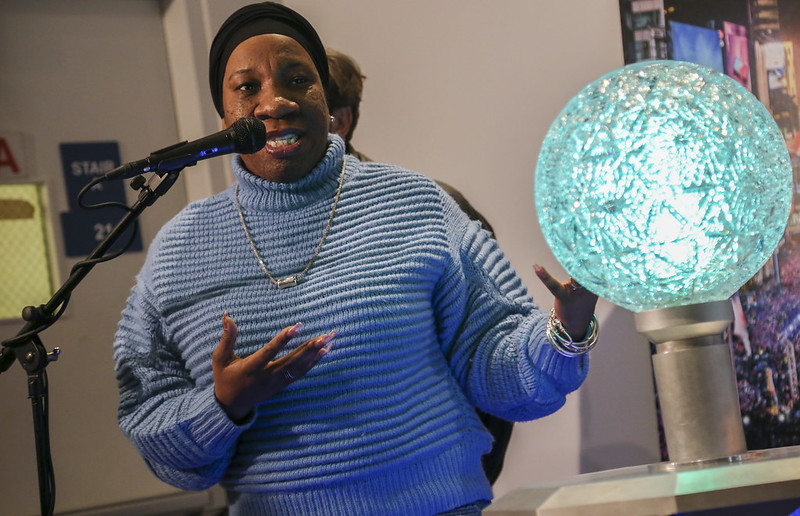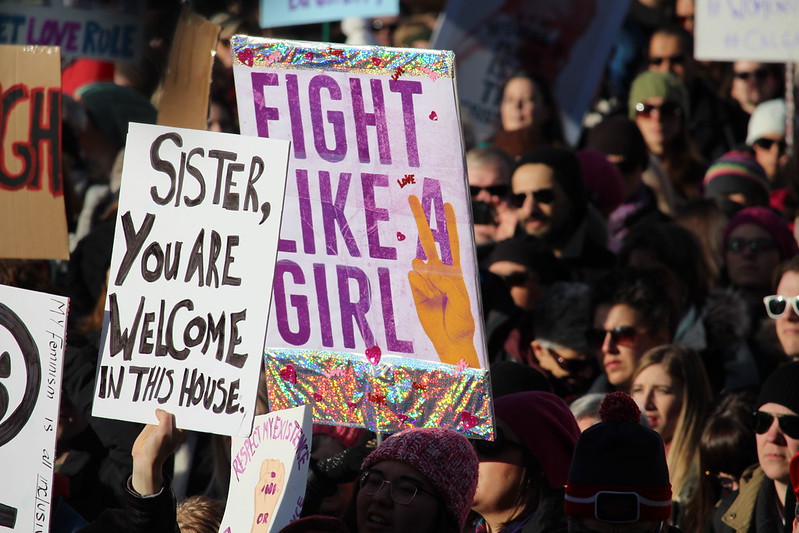These milestones—key initiatives, events, court cases and more from the past two decades—brought about pivotal shifts in the public consciousness towards sexual assault and the experience of survivors, and how we as individuals and as a society can prevent it.

This story originally appeared in the National Sexual Violence Resource Center. It has been republished with permission.
Since its opening in 2000, the National Sexual Violence Resource Center (NSVRC) has served as a hub for advocates, researchers and educators on the frontlines doing the work to support survivors and build communities free of sexual assault, harassment and abuse. Twenty years later, we continue to offer the latest resources on preventing sexual violence through services like our library’s continually growing collection of 47,000 resources, free online courses on sexual assault advocacy, and our new podcast, Resource on the Go.
The mission to end gender-based violence and adequately support survivors could not see progress without the contributions and actions of countless individuals, organizations and movements—so we want to celebrate the milestones and events that brought us to where we are today, by looking back on key initiatives, events, court cases and more from the past two decades that have shaped the work feminists do every day.
These milestones, while each meaningful in themselves, also brought about pivotal shifts in the public consciousness towards sexual assault and the experience of survivors, and how we as individuals and as a society can prevent it.
This list can help us recognize the ways in which incremental change builds while also reminding us of the work that still needs to be done, particularly in supporting communities and groups who are disproportionately impacted by sexual violence.

Between the years 2000 and 2005, there was a rise in public consciousness around issues relating to sexual assault through local awareness events and national media coverage, and federal legislation designed to end sexual violence.
First National Sexual Assault Awareness Month Campaign (2001)
In 2001, NSVRC coordinated the first national Sexual Assault Awareness Month (SAAM), building on the years of advocacy and awareness-building that had come before. Through this campaign, teal was solidified as the color associated with sexual assault awareness, and teal ribbons become the symbol of sexual assault awareness and prevention. SAAM events continue to support survivors and shine a light on sexual violence prevention in communities and on college campuses across the U.S. — with the first-ever completely virtual campaign taking place in April 2020. NSVRC continues to coordinate resources, graphics, and online organizing tools for SAAM events nationally.

Launch of The World Report on Violence and Health (2002)
The World Report on Violence and Health from the Centers for Disease Control and Prevention (CDC) and the World Health Organization (WHO) was the first extensive review of violence as a global public health issue. The report provided an overview of the issue of sexual violence, analyzed risk factors and the impact on victims, and described how a public health approach could be used to prevent it. Since its publication, over 30 governments around the world have used the report as a framework to assess the issue of violence and determine how best to prevent it. The WHO would later share the progress of international efforts to address violence in the Global Status Report on Violence Prevention (2014).
The U.S. is one example of a country using a public health approach, as, in the years that followed, the CDC took steps to treat sexual violence as a preventable issue by studying its prevalence and using the social-ecological model to prevent it, as described in the World Report. As part of their prevention work, the CDC released the National Intimate Partner and Sexual Violence Survey (NISVS) in 2011, another key report that highlighted prevention.
Sexual Abuse Within the Catholic Church (2002)
The Boston Globe’s investigation into widespread sexual abuse within the Catholic Church opened the public’s eyes to the issue of child sexual abuse and the role of institutions in preventing it. A national spotlight on the issue led to investigations and allegations that exposed a pattern of sexual abuse and cover-ups throughout the Catholic Church. Following the national media coverage of this story, victims of clerical abuse were emboldened to come forward with their stories, resulting in new investigations and lawsuits.
The Catholic Church would later take steps to bring about change, such as Pope Francis abolishing a secrecy law (2019) that protected pedophiles within the church, and in 2020, the Vatican issued new guidance to bishops around the world to report cases of clerical sexual abuse to authorities, even when it’s not required by local law.
Prison Rape Elimination Act (2003)
People who are incarcerated are at higher risk for sexual violence. The Prison Rape Elimination Act (PREA) was the first civil law created to stop sexual assault against incarcerated people.
PREA called upon the Department of Justice to develop national standards to prevent prisoner rape and for nationwide data collection on the issue. It also provided federal grants to help states prevent and respond to it. Thanks to the passage of this 2003 act, the PREA standards, released by the DOJ in 2012, would go on to bring about important changes in the prison system, including protections for LGBTQ prisoners, crisis services for victims, and prisoner education on the right to safety.
PreventConnect Is Launched (2004)
The California Coalition Against Sexual Assault launched PreventConnect as the first-ever online hub for web conferences and podcasts about preventing domestic and sexual violence. PreventConnect transformed the way sexual assault advocates from communities across the country could connect and facilitated a community of prevention practices among them. Sixteen years later, PreventConnect remains a trusted source of up-to-date information on prevention and a valued partner of NSVRC.
Violence Against Women Act Reauthorized (2005)
The Violence Against Women Act (VAWA), passed by Congress in 1994, was the first comprehensive federal legislative package designed to end violence against women. VAWA remains the primary federal law that provides legal protections and services to prevent and respond to crimes like domestic and sexual violence and stalking. VAWA’s reauthorization in 2000 and again in 2005 expanded the initial law to address sexual assault and stalking in addition to domestic violence. The 2005 reauthorization provided an increased focus on access to services for underserved populations such as communities of color, immigrant women, and tribal and Native communities.

During this five-year period, milestones show the continued growth of of the movement to end sexual violence alongside growing momentum to challenge injustice and inequality at all levels of society.
Me Too Movement Founded by Tarana Burke (2006)
Activist, community organizer, and advocate Tarana Burke began using the phrase “Me Too” in 2006 to raise awareness about the prevalence of sexual abuse and assault, particularly for Black women and girls while working at a nonprofit she founded focused on the well-being of young women of color. She coined the phrase, “me too” after a young girl disclosed that she was experiencing sexual abuse and Burke was left searching for the right words to let her know she wasn’t alone.

A decade later, the phrase would go viral as #MeToo and develop into an international social movement against sexual violence. Following the prominence of #MeToo and the impact it had, Burke would be featured among other activists called the “Silence Breakers” as the TIME Person of the Year for 2017.
First Presidential Proclamation to Declare April is Sexual Assault Awareness Month (2009)
For the first time ever, in 2009, the President of the United States officially declared April to be Sexual Assault Awareness Month. Through the proclamation, President Barack Obama encouraged citizens to develop policies at their workplaces and schools, have conversations about sexual assault with friends and family, and prioritize preventing sexual assault in their communities.
Since 2009, SAAM has continued to be recognized with a presidential proclamation every April.
Sexual Assault Demonstration Initiative Begins (2009)
The Sexual Assault Demonstration Initiative (SADI), a ten-year collaboration between NSVRC and the Resource Sharing Project, was the first large-scale project of its kind designed to learn about how organizations that serve both sexual assault and domestic violence survivors can best meet the needs of survivors in their communities. The project worked alongside six victim dual DV/SA organizations across the country to assess them and their communities.
The project resulted in key recommendations for dual DV/SA programs, including a willingness to modify their approaches when survivors’ needs are not being met and an awareness of the impact of trauma on staff members’ well-being. Lessons from SADI will continue to be explored in the new project Elevate|Uplift.
Matthew Shepard and James Byrd, Jr., Hate Crimes Prevention Act Signed Into Law (2009)
Named in honor of Matthew Shepard, a gay college student who was beaten to death in 1998, and James Byrd Jr., a Black man who was murdered by three white supremacists the same year, this act expanded hate crimes to include crimes motivated by a victim’s actual or perceived gender, sexual orientation, gender identity, or disability. The Act provided increased funding to state and local authorities to prosecute hate crimes and was a key step forward in protecting our most vulnerable populations from bias-motivated violence.
In the years that followed, there would be more progress for the LGBTQ community with the repeal of Don’t Ask Don’t Tell (2010), which allowed gay members of the military to serve openly, and the legalization of same-sex marriage (2015).
Report on Sexual Assault in the Military Released (2009)
The Final Report of the Defense Task Force on Sexual Assault in the Military Services shared the progress the Department of Defense had made in responding to victims of sexual assault since the establishment of its Sexual Assault Prevention and Response (SAPR) program in 2005. The report also provided findings and recommendations to improve prevention, victim response, and accountability.
PCAR/NSVRC’s former executivedDirector Delilah Rumburg served as a civilian member on the Task Force from

The years 2011 through 2015 saw expansion in the movement to end sexual violence, with a heightened focus on the role that institutions, such as colleges and universities, play in preventing sexual assault and protecting marginalized communities.
Department of Education Guidance Released (2011)
The Department of Education’s Office for Civil Rights “Dear Colleague” letter provided guidance to all federally funded institution of higher education to take steps to end sexual harassment and sexual violence on their campuses. The letter makes it clear that student-on-student sexual harassment, including all acts of sexual violence, is a form of sex discrimination prohibited by Title IX, the federal civil rights law that protects people from discrimination based on sex in education programs. The new guidance sparked a widespread focus on sexual violence prevention programming on topics like consent, bystander intervention, and more on college campuses throughout the country.
Jerry Sandusky Found Guilty (2012)
The sexual abuse conviction of former Penn State University football coach Jerry Sandusky showed that people who are well-respected in their communities can still commit abuse. Sandusky sexually groomed children participating in his youth charity foundation through gifts, money, and access to football games — introducing the term “grooming” into the public lexicon. In addition, university officials were charged with covering up and failing to report the abuse to protect the image of the prominent college-sport team over the welfare of children. This high-profile case led to public conversation on the role that institutions need to play in stopping abuse.
Violence Against Women Act Reauthorized (2013)
The reauthorization of the Violence Against Women Act in 2013 included expansions to address gaps in services for victims of sexual assault on Native American reservations. The new law, which took effect in 2015, allows tribes to criminally prosecute both Indians and non-Indians who assault Indian spouses or dating partners in Indian country. The 2013 VAWA renewal also included updated protections for immigrant women and anti-discrimination provisions to protect LGBT victims from being denied access to services.
Formation of the White House Task Force to Protect Students From Sexual Assault (2014)
Under President Obama, the White House formed a task force to create trainings and share guidance around preventing sexual assault on college campuses. This national focus on campus sexual assault is reflected in a few other notable events during this time period, including the founding of the national organization End Rape on Campus in 2013 and the release of The Hunting Ground in 2015, a documentary about the prevalence of campus sexual assault. The national SAAM campaign also reflected a focus on campus sexual assault during this time period.

These five years could be described as an explosion of public awareness and advocacy around sexual assault—from Hollywood to USA Gymnastics to the Supreme Court.
Emily Doe’s Victim Impact Statement Goes Viral (2016)
When Brock Turner was convicted in 2016 of sexually assaulting a young woman known then only as Emily Doe, Doe shared a victim impact statement in court, explaining how the assault had impacted virtually every aspect of her life. Later, the statement was posted on BuzzFeed and went viral, since it spoke to the shared experience of many survivors of sexual assault. It was shared across the internet, discussed on national news outlets, and even read aloud by members of the House of Representatives. Doe’s statement gave a vivid, well-crafted voice to the experiences of countless other survivors.
Three years later, in 2019, the author of the statement revealed that her name was Chanel Miller when she published a memoir called Know My Name expounding on the assault, the court case, and the subsequent attention.
Women’s Marches Are Held Worldwide (2017)
The Women’s March was held on January 21, 2017 in response to the 2016 presidential election. The guiding principles of the march focused on supporting women’s rights along with other various causes including, civil, reproductive, disability and LGBTQIA rights as well as the rights of workers and immigrants. While the main march was held in Washington, D.C., satellite events took place worldwide. Overall, more than five million people peacefully participated in the demonstration, making the Women’s March the largest single-day protest in U.S. history. From the marches, a movement began to encourage more civic participation among women, including running for office.

#MeToo Goes Viral (2017)
On October 15, 2017, actress Alyssa Milano posted a tweet inviting survivors of sexual assault or harassment to reply with “Me too.” There was an overwhelming response—the hashtag was tweeted almost a million times in just 48 hours.
This illustration of the prevalence of sexual assault wasn’t just confined to Twitter. The hashtag became a catalyst for countless allegations of sexual assault and harassment by prominent figures in the entertainment industry. #MeToo continued to expand beyond just Hollywood. The energy surrounding the movement galvanized states to enact new laws, companies to examine and revamp their policies, and individuals to have hard conversations with friends and loved ones about what sexual assault and accountability look like.
200 Larry Nassar Survivors Share Victim Impact Statements (2018)
In 2017, former USA Gymnastics doctor Larry Nassar was convicted on seven counts of criminal sexual conduct for sexually abusing over 150 girls he was supposed to be treating. On more than half a dozen occasions over the course of Nassar’s career, victims reported abuse, only to have their stories brushed aside in favor of protecting Nassar and the institution. At his sentencing hearing, more than 200 women who had survived his abuse read their victim impact statements aloud. For hours at a time, survivor after survivor shared the effect of the abuse on their life, and many of them drew strength from each other and their shared experiences. This story demonstrated the importance of listening to and supporting survivors when they bravely come forward and the role institutions must play in taking abuse seriously.
Dr. Ford Testifies (2018)
When it was announced that Justice Brett Kavanaugh would be nominated to the U.S. Supreme Court, a college professor from California named Dr. Christine Blasey Ford spoke out about an attempted sexual assault by Kavanaugh when they were in high school. Dr. Ford followed in the footsteps of Anita Hill, a lawyer who, in 1991, brought claims of sexual harassment against Justice Clarence Thomas before his confirmation to the Supreme Court.
Dr. Ford was called to testify before the Senate Judiciary Committee during Justice Kavanaugh’s confirmation hearing, where she used her expertise in psychology to explain her experience. Justice Kavanaugh was eventually confirmed, but Dr. Ford’s testimony led to widespread conversations about the impact of trauma on the memory and served as a reminder to start by believing survivors when they come forward.
As we reflect on the past twenty years, it is clear that the movement to end sexual violence is capable of significant change. This past year alone has seen unprecedented shifts and changes due to the COVID-19 pandemic, including the first completely virtual SAAM campaign and the first remote National Sexual Assault Conference. We look forward to continuing to be a part of this movement and seeing how it will grow and evolve.
Get caught up on the Ms. 16 Days of Activism collection.
You may also like:




